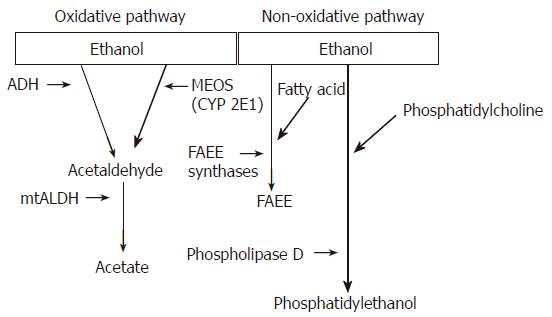Copyright
©2006 Baishideng Publishing Group Co.
World J Gastroenterol. Nov 21, 2006; 12(43): 6926-6932
Published online Nov 21, 2006. doi: 10.3748/wjg.v12.i43.6926
Published online Nov 21, 2006. doi: 10.3748/wjg.v12.i43.6926
Figure 1 Metabolism of ethanol in the liver via oxidative and non-oxidative pathways.
Oxidative pathway: In the first step of oxidation, ethanol is converted to acetaldehyde. Alcohol dehydrogenase (ADH) is the major enzyme. The microsomal ethanol-oxidizing system (MEOS) involves several cytochrome P450 proteins, of which cytochrome P450 2E1 (CYP2E1) is the major constituent. In the second oxidative step, acetaldehyde is rapidly metabolized to acetate by mitochondrial acetaldehyde dehydrogenase (mtALDH). Non-oxidative pathway: The non-oxidative pathway of ethanol metabolism involves the esterification of ethanol with fatty acids to form fatty acid ethyl esters (FAEE), a reaction catalyzed by FAEE synthases. The non-oxidative pathway also generates phosphatidylethanol via phospholipase D.
- Citation: Wang JH, Batey RG, George J. Role of ethanol in the regulation of hepatic stellate cell Function. World J Gastroenterol 2006; 12(43): 6926-6932
- URL: https://www.wjgnet.com/1007-9327/full/v12/i43/6926.htm
- DOI: https://dx.doi.org/10.3748/wjg.v12.i43.6926









